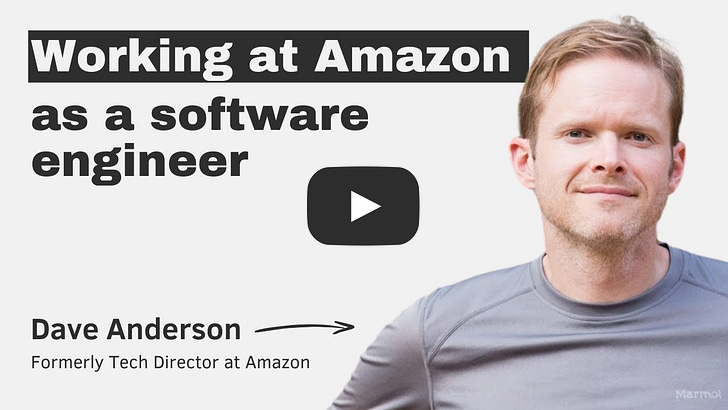Working at Amazon as a software engineer – with Dave Anderson
Working at Amazon as a software engineer – with Dave AndersonDave Anderson, formerly Tech Director at Amazon, shares an inside look at Amazon's engineering culture—from hiring and promotions to team autonomy and extreme frugality.Stream the Latest EpisodeListen and watch now on YouTube, Spotify and Apple. See the episode transcript at the top of this page, and timestamps for the episode at the bottom. Brought to You By
— In This EpisodeWhat is it like to work at Amazon as a software engineer? Dave Anderson spent over 12 years at Amazon working closely with engineers on his teams: starting as an Engineering Manager (or, SDM in Amazon lingo) and eventually becoming a Director of Engineering. In this episode, he shares a candid look into Amazon’s engineering culture—from how promotions work to why teams often run like startups. We get into the hiring process, the role of bar raisers, the pros and cons of extreme frugality, and what it takes to succeed inside one of the world’s most operationally intense companies. We also look at how engineering actually works day to day at Amazon—from the tools teams choose to the way they organize and deliver work. We also discuss:
 TakeawaysTopics I found especially interesting in our conversation: Amazon’s engineering levels: these go from L4 to L10:
Both autonomy and oncall are a given. Teams get to decide how they build things and what tech stack they use – and they are also responsible for oncall. Pretty much all engineers at Amazon are oncall for their team’s services on a rotation. Outages are taken very seriously – more so than at most companies. For SEV-1 outages (the highest severity) is common for VPs of Engineering or even SVPs to join in on the incident call. There is usually then a separate call for managers and individual contributors (ICs). This is extremely rare at most other Big Tech companies – and it shows how much Amazon cares about customer experience and operational excellence. The “Bar Raiser” is a pretty unique concept in Amazon’s hiring loops. The “Bar Raiser” is a very experienced interviewer who usually did 50- 100+ interviews and completed Bar Raiser training and signoff. They are the only one in the hiring loop – outside of the hiring manager – who can veto hiring decisions. The goal of this role is to ensure that all hiring loops come to fair decisions, and to avoid rookie hiring mistakes. Amazon’s engineering culture makes it easier for engineers to move to smaller startups – which is rare across Big Tech companies. At many other large companies, moving from Big Tech to a startup can be a big shock – as Big Tech usually has lots of internal, custom tooling, platform teams to support engineers, and so on. At Amazon, however, most engineering teams are already run like a startup, use AWS infra, and embrace the frugality value. Transitioning to a scrappy startup is usually much easier because of this – and it could be a reason why startups also like hiring from Amazon, and ex-Amazon engineers do well in smaller companies as well. An interesting quote from the episode
The Pragmatic Engineer deepdives relevant for this episodeTimestamps(00:00) Intro (02:08) An overview of Amazon’s levels for devs and engineering managers (07:04) How promotions work for developers at Amazon, and the scope of work at each level (12:29) Why managers feel pressure to grow their teams (13:36) A step-by-step, behind-the-scenes glimpse of the hiring process (23:40) The wide variety of tools used at Amazon (26:27) How oncall works at Amazon (32:06) The general approach to handling outages (severity 1-5) (34:40) A story from Uber illustrating the Amazon outage mindset (37:30) How VPs assist with outages (41:38) The culture of frugality at Amazon (47:27) Amazon’s URA target—and why it’s mostly not a big deal (53:37) How managers handle the ‘least effective’ employees (58:58) Why other companies are also cutting lower performers (59:55) Dave’s advice for engineers struggling with performance feedback (1:04:20) Why good managers are expected to bring talent with them to a new org (1:06:21) Why startups love former Amazon engineers (1:16:09) How Dave planned for an early retirement (1:18:10) How a LinkedIn post turned into Dave’s weekly newsletter: Scarlet Ink Note: for this episode, I decided to not add a summary. It was getting confusing to have both the summary and timestamps. I’m opting for somewhat longer takeaways, looking ahead. ReferencesWhere to find Dave Anderson: • X: https://x.com/scarletinked • LinkedIn: https://www.linkedin.com/in/scarletink/ • Newsletter: Mentions during the episode: • Inside Amazon's Engineering Culture: https://newsletter.pragmaticengineer.com/p/amazon • A Day in the Life of a Senior Manager at Amazon: https://newsletter.pragmaticengineer.com/p/a-day-in-the-life-of-a-senior-manager • Figma: https://www.figma.com/ • What is a ‘Bar Raiser’ at Amazon?: https://www.aboutamazon.eu/news/working-at-amazon/what-is-a-bar-raiser-at-amazon • AWS: https://aws.amazon.com/ • C: https://en.wikipedia.org/wiki/C_(programming_language) • Netflix on AWS: https://aws.amazon.com/solutions/case-studies/innovators/netflix/ • The Pulse #76: Why are layoffs coming hard and fast, again?: https://newsletter.pragmaticengineer.com/p/the-pulse-76 • Agile: https://www.atlassian.com/agile/ • Waterfall: https://www.atlassian.com/agile/project-management/waterfall-methodology • Scrum: https://www.atlassian.com/agile/scrum • Lisp: https://en.wikipedia.org/wiki/Lisp_(programming_language) • Bezos Academy: https://bezosacademy.org/ • The Amazon Leadership Principles - A Complete Interview Guide: • Mr. Money Mustache’s blog: https://www.mrmoneymustache.com/ • Mad Fientist: https://www.madfientist.com/ • The Simple Path to Wealth: Your road map to financial independence and a rich, free life: https://www.goodreads.com/book/show/30646587-the-simple-path-to-wealth • Notable Internal Systems at Amazon: https://blog.pragmaticengineer.com/amazon-notable-systems/ — Production and marketing by Pen Name. For inquiries about sponsoring the podcast, email podcast@pragmaticengineer.com. You’re on the free list for The Pragmatic Engineer. For the full experience, become a paying subscriber. Many readers expense this newsletter within their company’s training/learning/development budget. This post is public, so feel free to share and forward it. If you enjoyed this post, you might enjoy my book, The Software Engineer's Guidebook. Here is what Tanya Reilly, senior principal engineer and author of The Staff Engineer's Path said about it:
|


Comments
Post a Comment